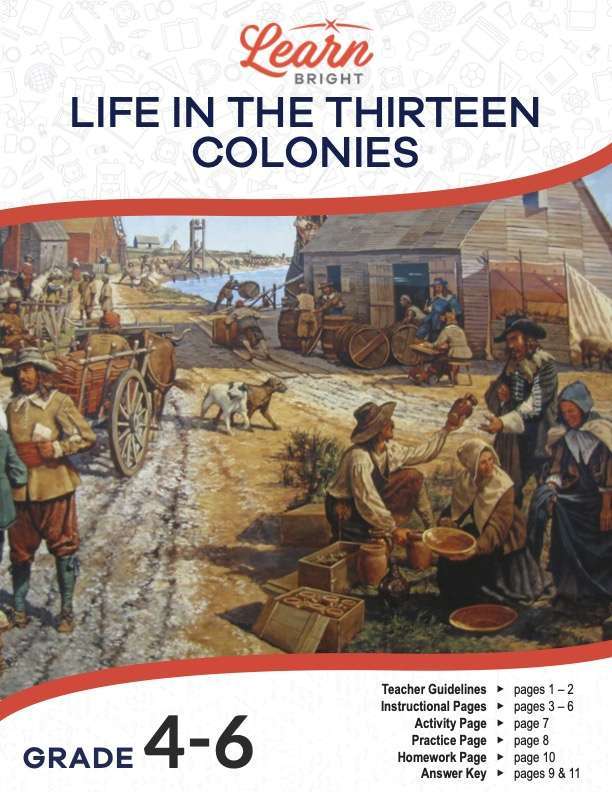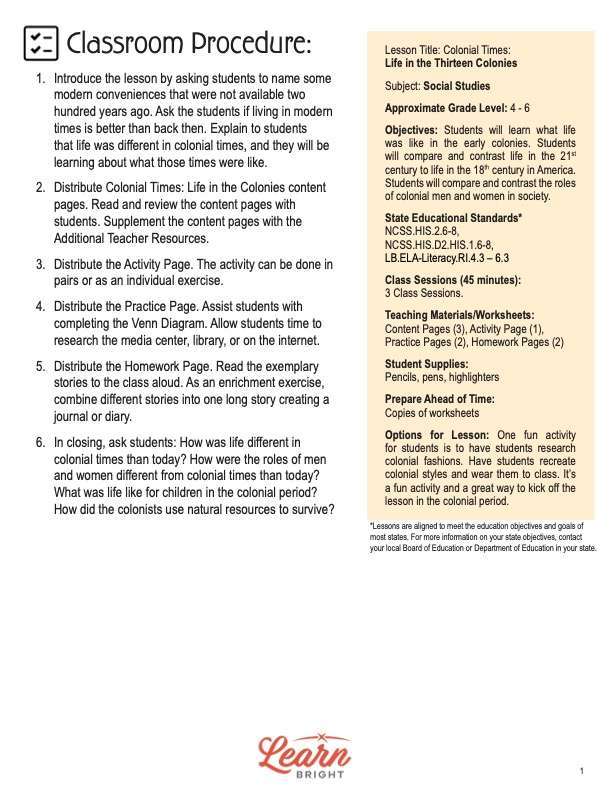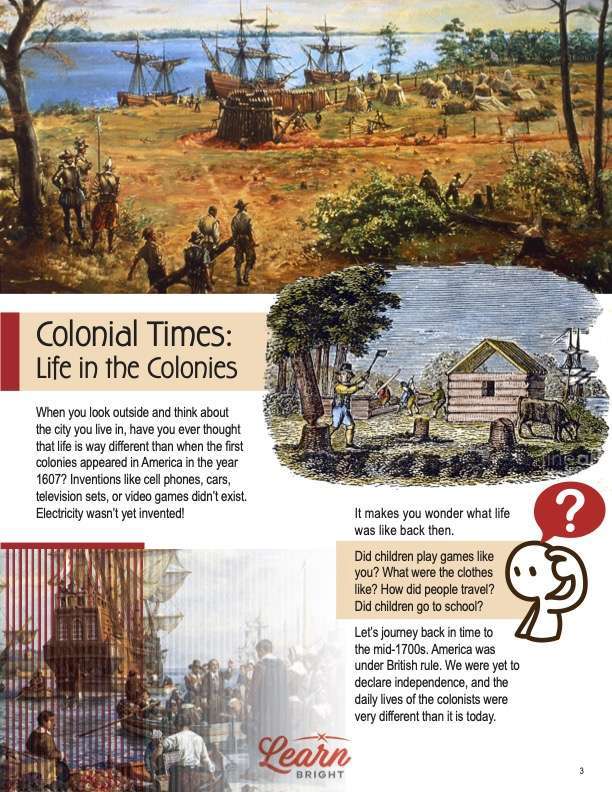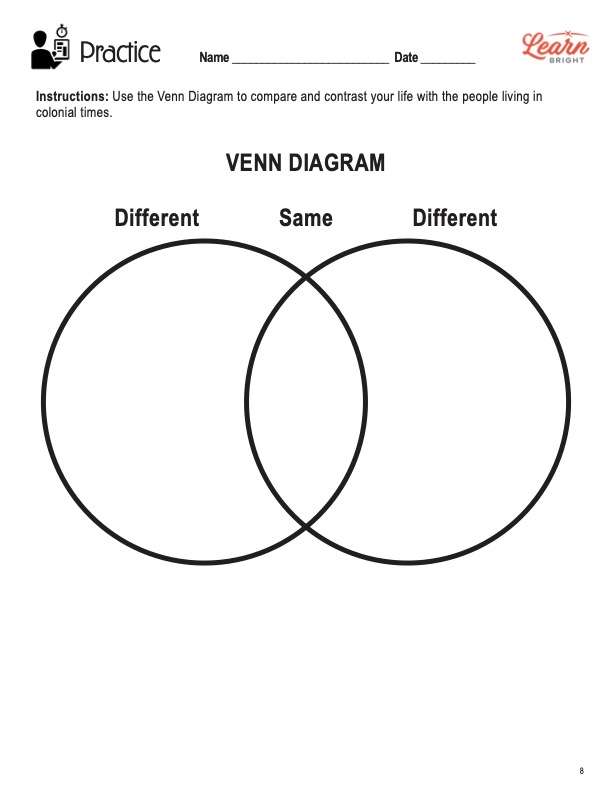Description
What our Life in the Thirteen Colonies lesson plan includes
Lesson Objectives and Overview: What was it like to live in the late 18th century? Life in the Thirteen Colonies teaches students what life was like for earlier settlers. Students will compare their own lives to those of the colonists. They will learn about the different roles of colonial men and women of society and how life was different for people living on farms and in cities. They will discuss how many aspects of life have changed in the last 200 years. This lesson is for students in 4th grade, 5th grade, and 6th grade.
Classroom Procedure
Every lesson plan provides you with a classroom procedure page that outlines a step-by-step guide to follow. You do not have to follow the guide exactly. The guide helps you organize the lesson and details when to hand out worksheets. It also lists information in the orange box that you might find useful. You will find the lesson objectives, state standards, and number of class sessions the lesson should take to complete in this area. In addition, it describes the supplies you will need as well as what and how you need to prepare beforehand. For this lesson, the supplies you will need are pencils, pens, and highlighters.
Options for Lesson
This lesson includes an “Options for Lesson” section that lists a number of suggestions for activities to add to the lesson or substitutions for the ones already in the lesson. For this lesson, there’s only one suggestion for the activity. You can have students do research on colonial fashion and have them recreate colonial clothing to wear to class. This is a fun activity for your students and will help kick off the lesson in an enjoyable way!
Teacher Notes
The teacher notes page includes a paragraph with additional guidelines and things to think about as you begin to plan your lesson. This page notes that students will learn how their lives differ from the lives people led during the colonial period. It also includes lines that you can use to add your own notes as you prepare for this lesson.
LIFE IN THE THIRTEEN COLONIES LESSON PLAN CONTENT PAGES
Introduction to Colonial Times
The Life in the Thirteen Colonies lesson plan includes four content pages. When you look outside and think about the city you live in, have you ever thought that life is way different than when the first colonies appeared in America in the year 1607? Inventions like cell phones, cars, television sets, or video games didn’t exist. Electricity wasn’t yet invented!
It makes you wonder what life was like back then. Did children play games like you? What were the clothes like? How did people travel? Did children go to school? Let’s journey back in time to the mid-1700s. America was under British rule. We were yet to declare independence, and the daily lives of the colonists looked very different than it does today.
Children in the Thirteen Colonies
Young men and boys could also learn a trade to become a blacksmith, tailor, wheelwright, or shoemaker. Wealthy families in larger cities would send their male children to private academies where they learned things like Greek and Latin. Not all children attended school, and many simply worked on farms or learned a trade. In their limited free time, the children of this time enjoyed playing with other kids, just as they do today.
Some children had a chance to go to school. School usually was held in the church or some public building. It was a one-room school, and children from the age of seven to sixteen would be in the same class. In most of the early schools, the minister taught the class. Ministers would be the best-educated person in town. And they taught nearly all of the lessons from the Bible since books were very scarce and expensive. Students would sit on hard wooden benches and write on tablets.
There were also boys as young as six or seven years old who would spend nearly seven years learning a trade. These young boys were called apprentices. Once they learned the trade, they would become journeymen, but they would still work for a master and earn regular wages. During busy times, they might work up to 16 hours a day, six days a week.
In the larger cities primarily in the New England colonies, wealthy parents might hire a tutor or send their male children to private academies. The male students would learn Latin, Greek, and some basic math. Females did not have the same opportunities for learning as the boys. Many of them never learned to read or write unless someone at home taught them. Some families who could afford it might send their daughter to finishing schools where they were taught what was called the domestic arts—how to maintain a household.
Farm and City Life
The roles of men and women were quite different during colonial times. Most everyone during colonial times lived on a farm. Everyone, including children, worked six days a week and sometimes all of Sunday. The day’s work began when the sun first appeared in the morning sky and stopped when it was too dark to see. Sixteen-hour days were not uncommon, especially during the planting and harvesting seasons. While the males tended to much of the farm, females—when they were not helping to plant or harvest—made clothing, soap, candles, and other goods the family needed.
If you lived in the city and worked in a trade such as carpentry, life was not much different than that of farmers. Most of your day was spent working in your shop, fixing and repairing or building things for local people living in the town. If you were a professional like a lawyer, merchant, or someone who owned their own business, your business was open nearly every day of the week.
Men were expected to work at a trade or in farming. Women were responsible for taking care of the home. Men had certain rights that women did not. For example, men could own property, participate in public town meetings, and vote. Women could not do any of those things! Even women living in cities had to be careful where they went, who they were seen with, and the kinds of activities they could do.
Women stayed home and took care of the children. They made their clothing, soap, candles, and many other goods and products that their families needed all by hand. Also, they had to prepare, cook, and serve the meals, sometimes with food from small gardens they tended. While living in the colonies was hard for everyone, women had to work incredibly hard to maintain the family and home.
Housing
Building supplies were hard to come by in the colonies. Making do with what was available meant that people had to repurpose the trees they cut down to clear the land. They would use the wood to build log or wood homes. Most of the housing consisted of small, single-room homes. Families would share the living space.
The frames of the houses were wooden. They made roofs from dried grasses, and the floors were just dirt. They had windows that usually opened or were covered with wooden shutters. There was a fireplace inside for cooking and providing heat during the winter. Because there was little space, most homes had only a table, a few chairs, and possibly a small cupboard. Oil lamps lit the rooms at night.
As the cities began growing, building supplies became more available. City colonists were able to enjoy homes with lead glass windows, stylish furniture, and separate rooms. Rooms in the houses were built with multiple fireplaces and several windows.
One interesting aspect of homes in the city was that people would move to different rooms depending on the season of the year. For example, in the winter they might stay in the front of the house where the sun shined because it was warmer there. During the hot summer, they would move to the back, away from the heat of the sun.
Clothing and Slavery
The colonists had very little material to work with when it came to
clothing. Just like what they used to build homes, the colonists used
what they found in nature. The men wore loose linen shirts tucked into their pants that reached to the knee. Socks were long and made of wool. They wore a sleeveless jacket, plain leather shoes, wide-brimmed hats, and coats or capes for protection from cold or rain.
Women usually wore a long, loose dress. Over that, they wore a long gown made of wool or linen. They wore aprons as well, which held their clothes in place when they tied them. Women would wear bonnets or tuck their hair into tightly knit hats. Like the men, they wore long wool socks and shoes made of leather. When it was cold, like the men, they wore a cape or coat to protect themselves from rain or bad weather.
Both men and women in the city wore more fashionable attire than the colonists living on farms. Regardless of where they lived, colonial fashion can be described as very practical, modest, durable, and easy to care for.
The first slaves appeared in the colonies in 1609 at Jamestown. From 1609, slavery became a common practice in all of the thirteen colonies. Most of the slaves came from the African coast, South America, and the Caribbean. They were forcibly removed from their native homelands and transported to the Americas by Dutch, Spanish, or British slave ships.
Because many of the slaves were so tightly packed into the ships’ cargo bay, many slaves would not survive the journey. Or they would arrive very sick. Once they arrived in America, the slaves were transported to large slave auction houses and sold to the highest bidder. Slaves remained part of the manual labor force until the Civil War in 1865 ended the practice. Slavery is one of the most tragic events in American history.
LIFE IN THE THIRTEEN COLONIES LESSON PLAN WORKSHEETS
The Life in the Thirteen Colonies lesson plan includes three worksheets: an activity worksheet, a practice worksheet, and a homework assignment. You can refer to the guide on the classroom procedure page to determine when to hand out each worksheet. These worksheets test student’s understanding of the lesson material.
LIFE IN THE THIRTEEN COLONIES ACTIVITY
The activity requires students to answer questions based on the reading passage. Students will have to demonstrate critical thinking in answering some of these questions. For example, students will have to answer “What was life like for children during colonial times?” and “What year and where did the first slaves appear in America?”
An option for an additional activity is to have students research colonial fashion prior to the lesson. They can recreate the styles and wear them to class to kick off the subject. Students will become interested in this topic because of this fun and creative activity.
VENN DIAGRAM PRACTICE WORKSHEET
For this practice worksheet, students will fill in a Venn diagram to compare and contrast their life with the people in colonial times. The practice worksheet will further solidify student’s comprehension of the topic. Students will use the lesson material to fill in details from the colonial times and their experience of their own lives to compare and contrast. They can add details about their homes, food, clothing, upbringing, and more.
WRITE A STORY HOMEWORK ASSIGNMENT
The homework assignment requires that students write a story from the perspective of a colonial child. They will use the information they learned in the lesson to describe what they might see or do. Students will include what life was like, the things they would see or do during a day in the colonial times, and descriptions of things like clothing, where they live, and the chores or jobs they would do.
Worksheet Answer Keys
This lesson plan includes answer keys for the practice worksheet and the homework assignment, though both answer keys simply note that answers will vary. If you choose to administer the lesson pages to your students via PDF, you will need to save a new file that omits these pages. Otherwise, you can simply print out the applicable pages and keep these as reference for yourself when grading assignments.









